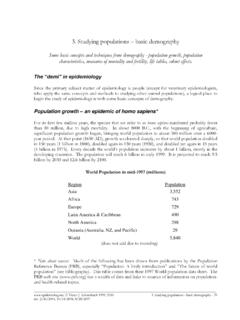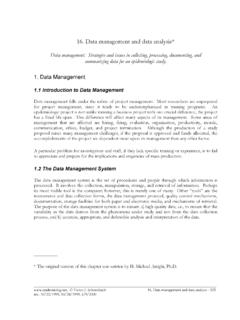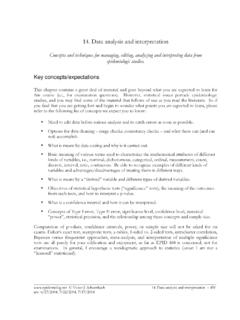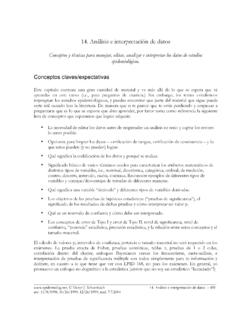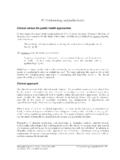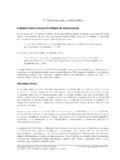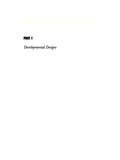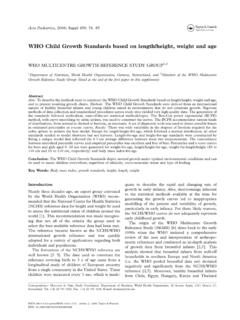Transcription of Epidemiologic study designs - Epidemiology learning materials
1 8. Analytic study designs The architecture of the various strategies for testing hypotheses through Epidemiologic studies, a comparison of their relative strengths and weaknesses, and an in-depth investigation of major designs . Epidemiologic study designs In previous topics we investigated issues in defining disease and other health-related outcomes, in quantitating disease occurrence in populations, in relating disease rates to factors of interest, and in exploring and monitoring disease rates and relationships in populations. We have referred to cohort studies, cross - sectional , and case-control studies as the sources of the measures we examined, but the study designs themselves were secondary to our interest. In the present chapter we will define and compare various study designs and their usefulness for investigating relationships between an outcome and an exposure or study factor.
2 We will then examine two designs intervention trials and case-control studies in greater depth. The study designs discussed in this chapter are called analytic because they are generally (not always). employed to test one or more specific hypotheses, typically whether an exposure is a risk factor for a disease or an intervention is effective in preventing or curing disease (or any other occurrence or condition of interest). Of course, data obtained in an analytic study can also be explored in a descriptive mode, and data obtained in a descriptive study can be analyzed to test hypotheses. Thus, the distinction between "descriptive" and "analytic" studies is one of intent, objective, and approach, rather than one of design. Moreover, the usefulness of the distinction is being eroded by a broad consensus (dogma?)
3 In favor of testing hypotheses. Since to characterize a study as "only descriptive" tends to devalue it, investigators understandably try to portray their studies as "analytic". and "hypothesis-driven" in order to make a better impression and to improve their chances for funding and journal space. (Opinions expressed herein are not necessarily those of the sponsor!). Whether the study is "descriptive" or "analytic", it is important to clearly identify the objectives of the study (preferably identifying the specific parameters to be measured see Rothman and Greenland) and the rationale ( , the case for conducting the research). There are innumerable decisions, judgments, and compromises that must be made during the design, conduct, analysis, and interpretation of a study , and the principal guideposts for making them are the study objectives and rationale.
4 For example, if the objective is to test hypotheses, then the investigator designs and conducts the study so as to maximize the usefulness of the data for testing these hypotheses. Failure to keep the study objectives prominently in one's mind increases the advantage of hindsight over foresight. Epidemiologic investigations of disease etiology encounter many challenges, especially when they must contend with one or more of the following: 1. Difficulties in defining and measuring the disease;. _____. , Victor J. Schoenbach 1999 8. Analytic study designs - 209. rev. 9/6/1999, 10/7/1999, 12/17/1999. 2. Imprecision in determining the time of onset of the disease;. 3. Prolonged intervals between exposure to a causative agent and disease onset (induction period) and between disease onset and detection (latency).
5 4. Multifactorial disease etiology; and 5. Differential effect of factors of interest on incidence and course of the disease. [See Mausner and Kramer, Chapter 7, pp 178 et seq.]. Even more daunting can be studies of phenomena other than clinical diseases, where less assistance is available from the biomedical armamentarium. In view of these and other challenges, including the logistical and practical ones of obtaining access to subjects, measuring variables of interest, protecting subjects' rights, and assembling sufficient cases for rare diseases, the basic Epidemiologic analytic strategy may be characterized as "by any (ethical) means necessary", along with "try to get the best but if you have to, make do with what's available". For this reason there are innumerable variations in the details of study design.
6 But in terms of the basic architecture - how the principal components of a study are assembled - there are certain basic designs . Traditional classification of Epidemiologic study designs A logical sequence of study designs encountered in Epidemiology is: 1. Case reports 2. Case series 3. Ecologic (also called correlational). 4. cross - sectional 5. Case-control 6. Follow-up/cohort 7. Intervention trials/controlled trials The first two of these designs are employed in clinical, rather than Epidemiologic , studies, but often are precursors to Epidemiologic studies. The next two designs are regarded as primarily descriptive, the last design is primarily analytic, and designs 5 and 6 can be employed in analytic (hypothesis testing) or descriptive modes, depending upon the extent to which the study is oriented towards a pre-existing specific hypothesis.
7 Of course, it may be difficult to obtain resources for a lengthy or expensive study without a priori hypotheses, but there are exceptions. Of course, once the data have been collected for whatever purpose, they will often be subject to a search ("search and destroy", as some would have it; "seek and ye shall find" in the view of others) for other associations and insights. _____. , Victor J. Schoenbach 1999 8. Analytic study designs - 210. rev. 9/6/1999, 10/7/1999, 12/17/1999. Progression of types of studies In the classic or ideal scenario, studies of disease etiology unfold from simple, inexpensive, and rapid investigations that identify hypotheses to complex, costly, and lengthy ones to evaluate these hypotheses. General, exploratory studies typically take place before highly focused studies.
8 New syndrome or outbreak The stimulus to investigating disease etiology may be prompted by the appearance of a new or previously unrecognized syndrome. In this case the initial efforts will be aimed at characterizing the syndrome, developing a case definition, and searching for characteristics that differentiate people with the disease from persons without the disease. Or, a previously recognized disease may occur in a population group or geographical area where it has not been thought to occur. Such nonroutine situations then prompt a case report in a medical journal, notification of public health officials, or other actions that lead to initial studies typically case series's and outbreak investigations to define the nature of the situation and to look for leads to its cause. As we recounted in an earlier chapter, the history of AIDS Epidemiology followed this classic pattern.
9 Recognition of AIDS began with case reports and case series's describing cases of young otherwise healthy men in California and New York City with Pneumocystis carinii pneumonia (PCP). and Kaposi's Sarcoma (MMWR 1981;30:250-2 and 305-8). Before that time, PCP had been seen only in persons who had been medically immunosuppressed in connection with a transplant operation. Kaposi's Sarcoma had been known as a disease of Africans and elderly men of Mediterranean origin. The initial case series's described common and variable features of the syndrome. For example, all of the patients were men who had sex with men, most had a large number of male sex partners, and many used inhalants, a type of recreational drugs. The case series's led to an initial AIDS case definition for the purposes of identifying additional cases and inaugurating surveillance.
10 With a case definition in hand, it was also possible to conduct case-control studies in which persons with the disease could be compared with persons without the disease and characteristics associated with the condition identified. Comparisons of AIDS cases to apparently healthy male homosexual controls indicated that the cases had higher numbers of partners, had greater involvement in certain sexual practices (anal intercourse, fisting), and more exposure to drugs used to enhance sexual pleasure. These findings led to analytic studies to test these and other exposure hypotheses. Case reports and case series's are the clinical route to definition and recognition of disease entities and to the formulation of hypotheses. These studies are not " Epidemiologic " in the sense that they have no explicit comparison group or population reference.
